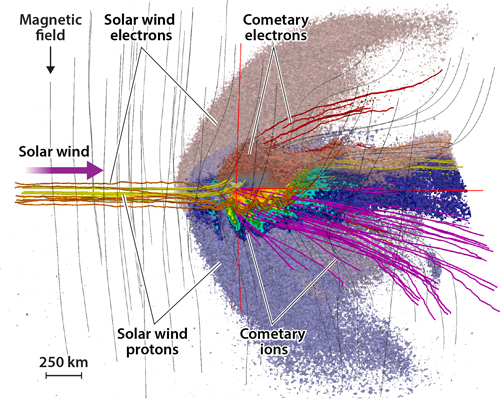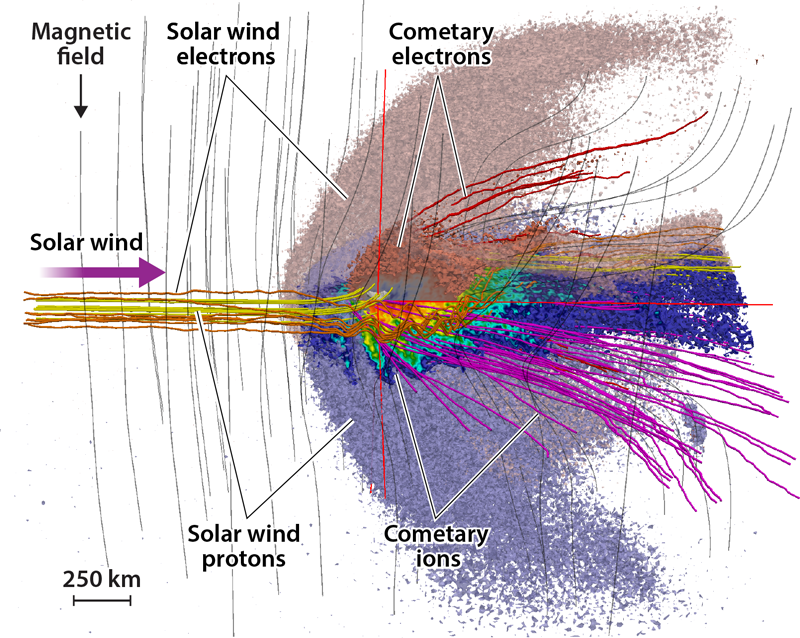3D View of a Comet’s Neighborhood
Practically anyone can recognize the distinct shape of a comet in the night sky: a small “match-head halo” with a long, feathery tail. Both the halo and tail are formed of material that sublimates off an icy nucleus and is then dragged out by the solar wind that fills interplanetary space. But the physics of the interaction between the solar wind and the comet material is surprisingly complex and hard to capture using conventional analysis or magnetohydrodynamic (fluid) simulations. Jan Deca, from the University of Colorado Boulder and NASA/SSERVI, and colleagues [1] have now produced detailed 3D particle-kinetic simulations of the intricate interaction between the solar wind and a comet. The results provide a clear “overview” of the rich physics of the most common cometary halos, including that of comet 67P/Churyumov-Gerasimenko observed by the Rosetta spacecraft.
The solar wind is a hypersonic flow of tenuous plasma that streams out from the Sun. Its existence was inferred in the 1950s from observations of comet tails [2] and finally detected directly with the Mariner 2 spacecraft during the early space program [3]. More recently, long-exposure images of comet tails, observed with NASA’s STEREO spacecraft, have been used to probe large-scale turbulence and gustiness in the solar wind itself [4]. The observed large-scale structure of the tails has also been used to probe the composition and volatile content of different comets [5].
Both the solar wind and cometary halo material are collisionless, that is, their constituent particles never interact directly with one another. Nevertheless, all of the particles making up the solar wind and any comet tails within it affect one another via the large-scale electromagnetic field that the particle ensemble generates. They form a multicomponent plasma in which different fluids of particles interact weakly while occupying the same space. Detailed interactions between individual populations of particles and the field are also important and percolate across spatial scales, yielding a hybrid system that is complex to treat numerically.
Deca and colleagues used 3D particle-in-cell (PIC) kinetic simulations, which are intended for exactly this kind of system. The plasma is treated as a collection of individual noninteracting particles that each collectively modify a large-scale electromagnetic field defined at discrete cell locations. The mass (and charge) of each simulated particle is typically larger than the actual physical particles, but the ensemble yields more complex collective behaviors than would a fully fluid-dynamic model. In particular, the simulations capture nonequilibrium systems such as collisionless plasmas, and they can be directly compared to composition and energy-spectrum measurements made with in situ sampling of a physical plasma.
The Rosetta rendezvous mission to comet 67P/Churyumov-Gerasimenko revealed a great many details of the evolution of the comet [6]. First, the mission revealed an expected cometary magnetosphere formed by “draped” magnetic field lines, which are carried by the solar wind as electric currents form in the ionized halo [7]. Second, it detected the presence of surprising “singing comet” oscillations [8], which involve undulations in the magnetic field that produce a striated structure in the outflowing ion tail. Third, Rosetta made the unexpected discovery of two distinct populations of electrons in the photoionized cometary halo. One population was “warm” with typical thermal energy of 5 eV (58,000 K), and the other “suprathermal” population had up to 4 times that energy [9]. These observations indicated that the material is not in local thermal equilibrium and raised questions of how the suprathermal population, which is difficult to reproduce using conventional fluid simulations, is accelerated.
Deca and colleagues’ PIC simulations of the interaction between the solar wind and a cometary halo use four fluids, each comprising a population of particles: electrons and protons in the solar wind and electrons and water ions in the halo. At the largest spatial scale, the simulations reveal a surprisingly coherent exchange interaction between all four fluids in the vicinity of the comet. Electrons from the solar wind and from the cometary ions exchange roles cleanly as the four fluids interact. This yields distinct streams of heterogeneous plasma, downwind from the comet, with different sources for the ions and electrons in each stream (Fig. 1).
More specifically, electrons and protons in the solar wind react quite differently to the comet because of their different charge-to-mass ratios. Magnetic-field lines entrained in the solar wind drape around the comet as the solar wind interacts with the halo. This produces a lateral field that steers the solar wind around the comet. But in contrast to the solar wind electrons, solar wind protons are only slightly deflected by the bent field lines. They penetrate deep into the halo and pass closer to the nucleus than do the solar wind electrons. Downwind of the comet, those protons are neutralized by outflowing electrons from the comet, off the main axis of the comet’s tail. Meanwhile, the solar wind electrons neutralize water ions emerging from the comet. The water ions form the familiar ion tail directly downwind of the comet. This charge exchange, which also carries momentum from solar wind particles to the comet particles, may be fundamental to rapid pickup of the ion tail into the solar wind. Further, the authors speculate that it plays a role in the enigmatic singing comet oscillations observed by Rosetta [10].
The suprathermal electron population found by Rosetta appears to be produced by selection effects in the overall electron population: escaping cometary electrons are selected for higher-than-average kinetic energy, producing a suprathermal energy tail. This happens because when newly evaporated cometary atoms separate into ions and electrons, each electron moves much faster than the remaining ion and therefore departs more quickly. Thus the nucleus and halo develop a slight positive potential, which new electrons must overcome to escape the vicinity of the comet. The potential is proportional to the average thermal energy of the cometary electrons, and it is only partially neutralized by infalling solar wind electrons, even though the system may be in stationary equilibrium [11]. Deca and colleagues reproduce this selection effect with their simulations, although they do not rule out other possible mechanisms, such as electron acceleration by electromagnetic or Alfvén waves that produce traveling regions of nonzero electric field.
PIC simulations such as those performed by Deca and co-workers are necessary to reveal the full dynamics of the solar wind-comet interaction and to capture the complex cometary environment. This first four-fluid 3D PIC simulation of a cometary halo explains several key measurements, including the rapid pickup of cometary plasma into the solar wind, the development of singing comet oscillations, and the presence of weakly accelerated suprathermal electrons near the halo. As such, it is an important step towards understanding comets and, by extension, the solar wind. Further simulations can and should explore these phenomena in more detail, to build a more refined overall picture of cometary dynamics.
This research is published in Physical Review Letters.
References
- J. Deca, A. Divin, P. Henri, A. Eriksson, S. Markidis, V. Olshevsky, and M. Horanyi, “Electron and Ion Dynamics of The Solar Wind Interaction with a Weakly Outgassing Comet,” Phys. Rev. Lett. 118, 205101 (2017).
- L. Biermann, “Physical Processes in Comet Tails and their Relation to Solar Activity,” Liege International Astrophysical Colloquia 4, 251 (1952).
- M. Neugebauer and C. W. Snyder, “Solar Plasma Experiment,” Science 138, 1095 (1962).
- C. E. DeForest, W. H. Matthaeus, T. A. Howard, and D. R. Rice, “Turbulence in the Solar Wind Measured with Comet Tail Test Particles,” Astrophys. J. 812, 108 (2015).
- N.-E. Raouafi, C. M. Lisse, G. Stenborg, G. H. Jones, and C. A. Schmidt, “Dynamics of HVECs Emitted from Comet C/2011 L4 as Observed by STEREO,” J. Geophys. Res. A 120, 5329 (2015).
- M. G. G. T. Taylor, C. Alexander, N. Altobelli, M. Fulle, M. Fulchignoni, E. Grun, and P. Weissman, “Rosetta begins its Comet Tale,” Science 347, 387 (2015).
- H. Nilsson et al., “Birth of a Comet Magnetosphere: A Spring of Water Ions,” Science 347, aaa0571 (2015).
- I. Richter et al., “Observation of a New Type of Low-Frequency Waves at Comet 67P/Churyumov-Gerasimenko,” Ann. Geophys 33, 1031 (2015).
- G. Clark et al., “Suprathermal Electron Environment of Comet 67P/Churyumov-Gerasimenko: Observations from the Rosetta Ion and Electron Sensor,” Astron. Astrophys. 583, A24 (2015).
- C. Koenders, C. Perschke, C. Goetz, I. Richter, U. Motschmann, and K. H. Glassmeier, “Low-Frequency Waves at Comet 67P/Churyumov-Gerasimenko,” Astron. Astrophys. 594, A66 (2016).
- E. Vigren, M. Galand, A. I. Eriksson, N. J. T. Edberg, E. Odelstad, and S. J. Schwartz, “On the Electron-to-Neutral Number Density Ratio in the Coma of Comet 67p/Churyumov–Gerasimenko,” Astrophys. J. 812, 54 (2015).





